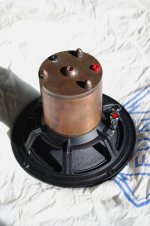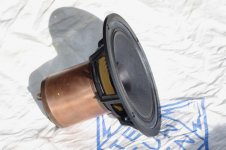Some of you may have seen this pair floating around at RMAF. I'm the lucky guy who got to bring them home! Dave Slagle designed and built the motor. Of course, the speaker really isn't specifically a Betsy or BetsyK, as the Q depends on the voltage at which you run the motor. You'll also notice the black cones. I've haven't posted it yet, but all new Betsys and BetsyKs have the new black cone. This pair sounds great in my OBs. I'm putting about 16V through them with an old HP lab supply. In addition to the FC/permanent magnet difference, this pair benefits from a much fancier, copper plated pole piece. All of the soft parts (cone, suspension, voice coil) are identical to a regular Betsy or BetsyK.
These aren't available for sale yet, nor can we nail down a price. It certainly is possible to build more.
Paul
Wild Burro Audio Labs - DIY Full Range Speakers
These aren't available for sale yet, nor can we nail down a price. It certainly is possible to build more.
Paul
Wild Burro Audio Labs - DIY Full Range Speakers
Attachments
You know, I honestly haven't measured this pair. I think they're drawing a bit over an amp. Judging by efficiency, I think the Q was in the Betsy range at around 12V. They can take up to about 18V before heat becomes an issue. But, current and voltage are of course dependent on the wire gauge. I think Dave wound these with either 18g or 20g, as it is what he had on hand. If we do a production unit, I think it would be nice to make them work with a commonly available laptop smps.
Those three nuts cap threaded rods that hold the can together. Those diminish the winding window a bit, but make the can less expensive than drilling and taping the tube (its 1/4" thick pipe). These are just prototypes, and we're trying to figure out if this is enough copper or if we need to get more turns in there. Obviously, I don't need a super low Q on my open baffles. But, some folks may want to use these in BLHs, so it will be good if we can crank the flux up pretty high. There are many potential ways to balance performance and cost. Machining is a big cost, but so is wire.
Doesn't the copper look cool? All of the FC parts (aside from the wire) are steel, but copper plated. This is how they came from the plater. They could be polished, but I like this look and it certainly fits with the Slagle/Jackson/Emia aesthetic.
Paul
Wild Burro Audio Labs - DIY Full Range Speakers
Those three nuts cap threaded rods that hold the can together. Those diminish the winding window a bit, but make the can less expensive than drilling and taping the tube (its 1/4" thick pipe). These are just prototypes, and we're trying to figure out if this is enough copper or if we need to get more turns in there. Obviously, I don't need a super low Q on my open baffles. But, some folks may want to use these in BLHs, so it will be good if we can crank the flux up pretty high. There are many potential ways to balance performance and cost. Machining is a big cost, but so is wire.
Doesn't the copper look cool? All of the FC parts (aside from the wire) are steel, but copper plated. This is how they came from the plater. They could be polished, but I like this look and it certainly fits with the Slagle/Jackson/Emia aesthetic.
Paul
Wild Burro Audio Labs - DIY Full Range Speakers
Einric,
Dave can be a frustrating guy. I think he has a theory of why field coils sound better, but he doesn't like anything that sounds like marketing. He would advise that one listen to it and see for themselves.
Generally, keep in mind that the current flowing through the voice coil will, to a degree, affect the flux of the magnet. Different magnet materials can be affected differently. When I mentioned to Dave that I had read someone who proposed that field coils can lower distortion through this mechanism, he didn't disagree. But, he also pointed to a very, very expensive field coil fullranger and suggested that they may have designed the motor in such a way that it exaggerated this flux modulation. So, the jury is out on why field coils sound different, just as there is no agreement as to why different magnet materials (alnico, neo, etc) sound different. Some claim that they don't. Dave is a huge believer in field coils. The "listen and see" approach works fine if you are NYC and can go over to a friends house. In Scottsbluff, NE or Bozeman, it might be harder to find a comparison!
I was hoping someone would ask how they sound. I tend to be a bit skeptical, and I suspected they wouldn't be hugely different. I've always liked the Betsy and BetsyK, and I've been afraid that improvements wouldn't be worth the cost. Thats why I've avoided doing any tweaky stuff to the speaker. It isn't as if I couldn't stick in a phase plug or mess with the motor.
While I was worried that the field coils wouldn't be much better, I was hoping for something revolutionary rather than evolutionary. They exceed my wildest expectations. They sound very, very different in a very, very good way.
Paul
Wild Burro Audio Labs - DIY Full Range Speakers
Dave can be a frustrating guy. I think he has a theory of why field coils sound better, but he doesn't like anything that sounds like marketing. He would advise that one listen to it and see for themselves.
Generally, keep in mind that the current flowing through the voice coil will, to a degree, affect the flux of the magnet. Different magnet materials can be affected differently. When I mentioned to Dave that I had read someone who proposed that field coils can lower distortion through this mechanism, he didn't disagree. But, he also pointed to a very, very expensive field coil fullranger and suggested that they may have designed the motor in such a way that it exaggerated this flux modulation. So, the jury is out on why field coils sound different, just as there is no agreement as to why different magnet materials (alnico, neo, etc) sound different. Some claim that they don't. Dave is a huge believer in field coils. The "listen and see" approach works fine if you are NYC and can go over to a friends house. In Scottsbluff, NE or Bozeman, it might be harder to find a comparison!
I was hoping someone would ask how they sound. I tend to be a bit skeptical, and I suspected they wouldn't be hugely different. I've always liked the Betsy and BetsyK, and I've been afraid that improvements wouldn't be worth the cost. Thats why I've avoided doing any tweaky stuff to the speaker. It isn't as if I couldn't stick in a phase plug or mess with the motor.
While I was worried that the field coils wouldn't be much better, I was hoping for something revolutionary rather than evolutionary. They exceed my wildest expectations. They sound very, very different in a very, very good way.
Paul
Wild Burro Audio Labs - DIY Full Range Speakers
The frame is pretty isn't it? I don't think it makes sense for the regular Betsy/K. They are intended to offer great performance for the price, and the cast frame costs a bit more while doing next-to-nothing for the performance. In the cost structure of the Field Coil however, the additional cost is pretty small, and higher on the price spectrum, looks matter more. Sometimes I do wonder if I'd sell more Betsys and BetsyKs with that frame and a higher price, but I'd rather not do it!
Whizzer-less Betsys and BetsyKs (the WOW version, for With Out Whizzer) are always available as special order. Sometimes the wait is long, sometimes its only a couple of weeks. Cutting the whizzer off is pretty easy, but the whizzerless dustcap looks a little nicer than a jagged whizzer edge.
Paul
Wild Burro Audio Labs - DIY Full Range Speakers
Whizzer-less Betsys and BetsyKs (the WOW version, for With Out Whizzer) are always available as special order. Sometimes the wait is long, sometimes its only a couple of weeks. Cutting the whizzer off is pretty easy, but the whizzerless dustcap looks a little nicer than a jagged whizzer edge.
Paul
Wild Burro Audio Labs - DIY Full Range Speakers
For those not familiar with Dave Slagle's ventures in iron and copper, check out his blog. If you dig back a bit, you might notice some other notable field coils!
Paul
Wild Burro Audio Labs - DIY Full Range Speakers
Paul
Wild Burro Audio Labs - DIY Full Range Speakers
Likewise! I've been meaning to send you a congratulatory note.
Paul
Wild Burro Audio Labs - DIY Full Range Speakers
Paul
Wild Burro Audio Labs - DIY Full Range Speakers
Have you determined whether the output impedance of the power supply affects the sound? After all the voicecoil and field coil work like a transformer and the field coil may behave differently if it has a high source impedance or low source impedance. One easy way is to use a LM337 CCS to power it instead of a voltage supply.
If the field coil is large enough to self-resonate, I wonder if it could cause oscillation for the amplifier?
Also, I keep wondering why manufacturers use resistive voicecoils when they could just use copper and an external resistor. This would make it impossible for the voicecoil to heat up and under fault conditions the resistor would fuse and protect the speaker. Have you thought about this Paul? Would it be cheaper to use normal copper for the voicecoil? It would also make current-drive experiments more convenient.
- keantoken
If the field coil is large enough to self-resonate, I wonder if it could cause oscillation for the amplifier?
Also, I keep wondering why manufacturers use resistive voicecoils when they could just use copper and an external resistor. This would make it impossible for the voicecoil to heat up and under fault conditions the resistor would fuse and protect the speaker. Have you thought about this Paul? Would it be cheaper to use normal copper for the voicecoil? It would also make current-drive experiments more convenient.
- keantoken
field coils sound better then alnico ,this is the report on supravox user as there is the same speakers with different magnet....
the simple answer probably is that magnetic is slow to react ,have a curve and add distorsions , just see the need of copper plate on ceramic ,problem that alnico don't have , Eddy current and so on...
great plus is changing the voltage change the t/s ie the sound....
@ Keantoken , Rod coleman reg is the best options
@pjanda1 , if have more info on price or so ..please PM
Ciao
the simple answer probably is that magnetic is slow to react ,have a curve and add distorsions , just see the need of copper plate on ceramic ,problem that alnico don't have , Eddy current and so on...
great plus is changing the voltage change the t/s ie the sound....
@ Keantoken , Rod coleman reg is the best options
@pjanda1 , if have more info on price or so ..please PM
Ciao
- Status
- This old topic is closed. If you want to reopen this topic, contact a moderator using the "Report Post" button.
- Home
- More Vendors...
- Wild Burro Audio
- Wild Burro Field Coils!


